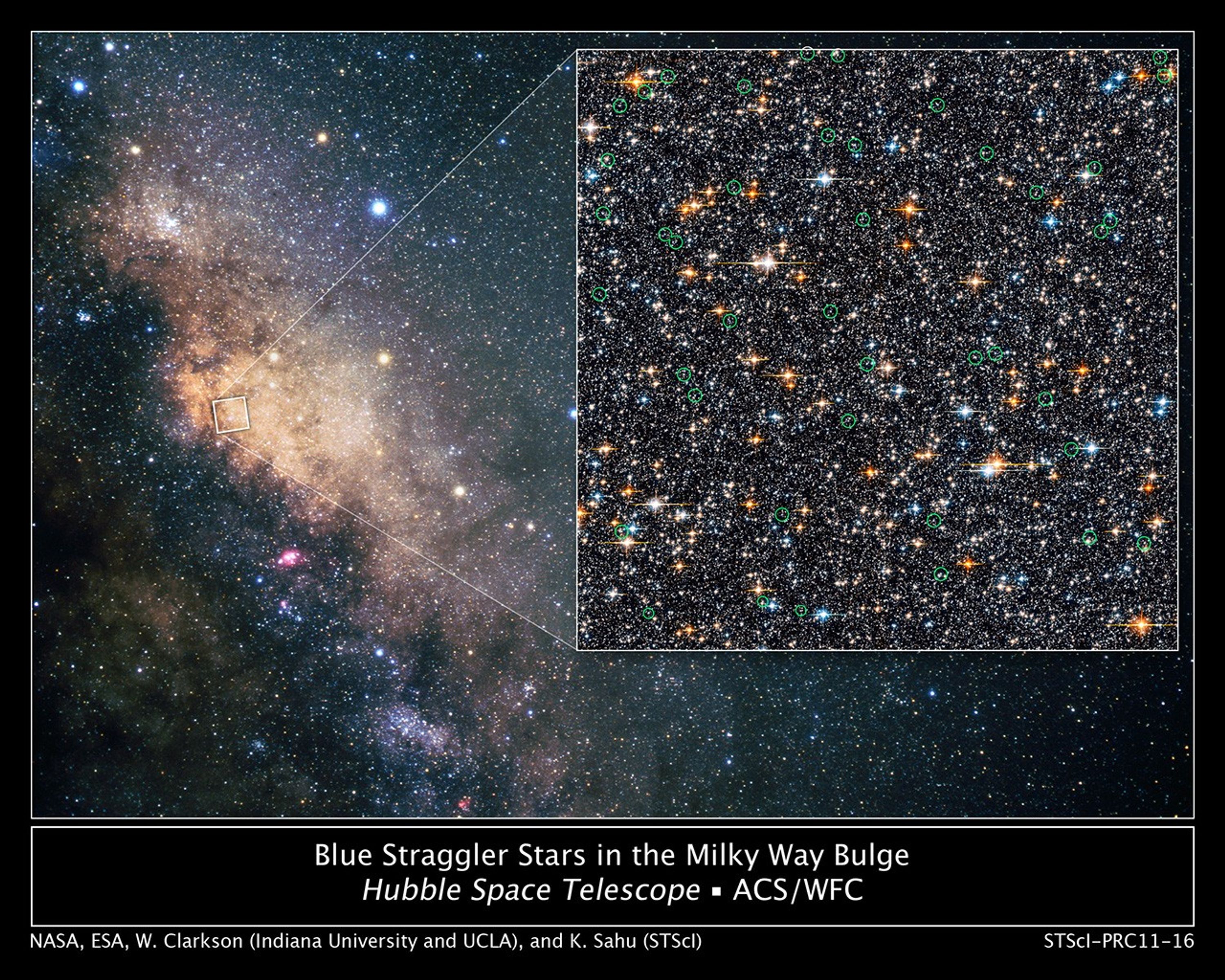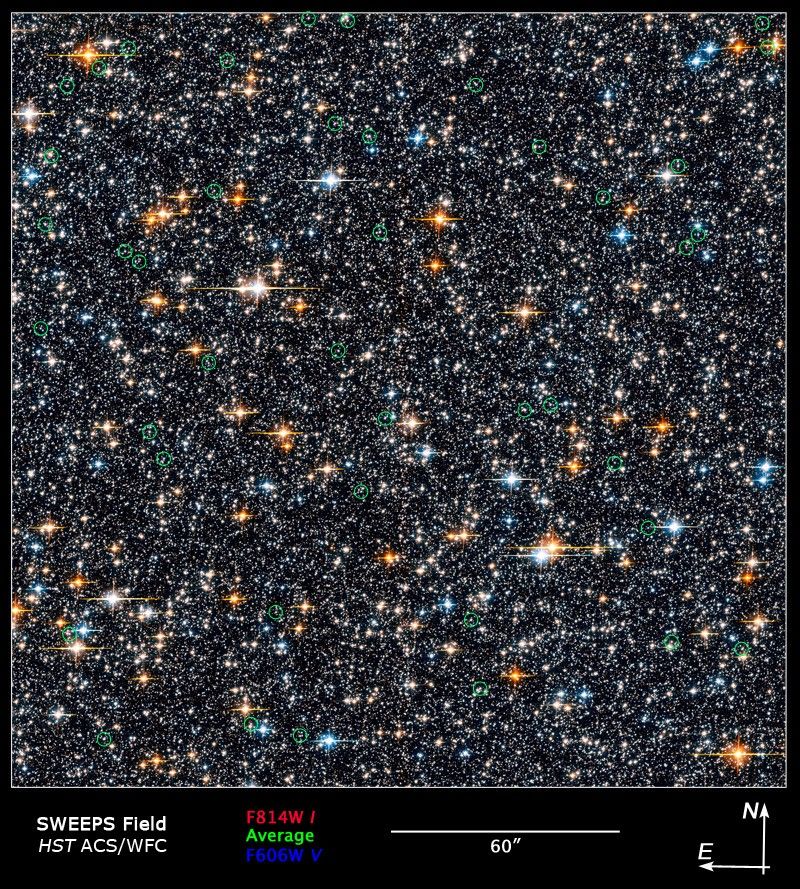1 min read
Hubble Finds Blue Straggler Stars in the Galactic Bulge

Peering deep into the star-filled, ancient hub of our Milky Way (left), the Hubble Space Telescope has found a rare class of oddball stars called blue stragglers, the first time such objects have been detected within our galaxy's bulge.
Blue stragglers – so named because they seem to be lagging behind in their rate of aging compared with the population from which they formed – were first found inside ancient globular star clusters half a century ago.
This discovery is a spin-off from a seven-day-long survey conducted in 2006 called the Sagittarius Window Eclipsing Extrasolar Planet Search (SWEEPS). Hubble peered at and obtained variability information for 180,000 stars in the crowded central bulge of our galaxy, 26,000 light-years away. The picture at right shows the 42 blue straggler candidates circled in green.
Blue stragglers have long been suspected to be located in the bulge. Until now, it has never been proven because younger stars in the disk of our galaxy lie along the line-of-sight to the core, confusing and contaminating the view. But Hubble's view is so sharp that astronomers could distinguish the motion of the core population from foreground stars in the Milky Way.
It's not clear how blue stragglers form, or if there is more than one mechanism at work. A common idea is that two stars collide and merge. This stirs up hydrogen fuel and causes the resulting, more massive star to undergo nuclear fusion at a faster rate, causing it to burn hotter and bluer.
The visible-light observations were made with Hubble's Advanced Camera for Surveys.
About the Object
- R.A. PositionR.A. PositionRight ascension – analogous to longitude – is one component of an object's position.17h 58m 59.99s
- Dec. PositionDec. PositionDeclination – analogous to latitude – is one component of an object's position.-29° 12' 0.0"
- ConstellationConstellationOne of 88 recognized regions of the celestial sphere in which the object appears.Sagittarius
About the Data
- Data DescriptionData DescriptionProposal: A description of the observations, their scientific justification, and the links to the data available in the science archive.
Science Team: The astronomers who planned the observations and analyzed the data. "PI" refers to the Principal Investigator.This image (inset) was created from HST data from proposal 9750: K. Sahu, R. Gilliland, H. Bond, S. Casertano, M. Livio, and N. Panagia (STScI), T. Brown (University Corporation for Atmospheric Research), D. Minniti (Catholic University of Chile), A. Renzini (Astronomical Observatory of Padova, Italy), R. Rich (University of California, Los Angeles), and M. Zoccali (Catholic University of Chile). The science findings also include data taken with the HST proposal 10466: K. Sahu (STScI) et al. Additional members of the science team include W. Clarkson (Indiana University and UCLA), and T. Brown, E. Smith, and J. Anderson (STScI). - InstrumentInstrumentThe science instrument used to produce the data.HST>ACS/WFC
- Exposure DatesExposure DatesThe date(s) that the telescope made its observations and the total exposure time.February 22 - 29, 2004, Exposure Time: 49 hours
- FiltersFiltersThe camera filters that were used in the science observations.F606W (R) and F814W (I)
- Object NameObject NameA name or catalog number that astronomers use to identify an astronomical object.SWEEPS Field
- Object DescriptionObject DescriptionThe type of astronomical object.Milky Way Galactic Bulge (left), and Stellar Field Near the Galactic Bulge (inset)
- Release DateMay 25, 2011
- Science ReleaseNASA’s Hubble Finds Rare Blue Straggler Stars in the Milky Way’s Hub
- Credit

This image (inset) is a composite of many separate exposures made by the ACS instrument on the Hubble Space Telescope using two different filters. Two filters were used to sample broad wavelength ranges. The color results from assigning different hues (colors) to each monochromatic image. In this case, the assigned colors are: Blue: F606W (R) Green: F606W (R) + F814W (I) Red: F814W (I)

Related Images & Videos

Blue Straggler Formation
This is an artist's concept of a close binary pair of stars that are merging to form a blue-straggler-class star. Blue stragglers are so named because they seem to be lagging behind in their rate of aging compared with the population from which they formed. The merger stirs up...
Share
Details
Claire Andreoli
NASA’s Goddard Space Flight Center
Greenbelt, Maryland
claire.andreoli@nasa.gov






























